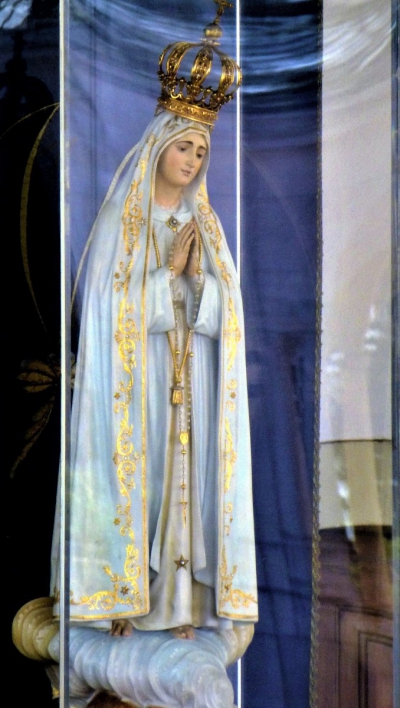Ftima (Portuguese pronunciation: [fatim] (listen)) is a city in the municipality of Ourm and district of Santarm in the Central Region of Portugal, with 71.29 km2 of area and 13,212 inhabitants (2021). The homonymous civil parish encompasses several villages and localities of which the city of Ftima is the largest.
The civil parish has been permanently associated with the Marian apparitions that were purportedly witnessed by three local shepherd children at the Cova da Iria in 1917. The Catholic Church later recognized these events as "worthy of belief". A small chapel was built at the site of the apparition, now known as Our Lady of Ftima, beginning in 1918, and a statue of her installed. The chapel and statue have since been enclosed within the Sanctuary of Our Lady of Ftima, a shrine complex containing two minor basilicas. Associated facilities for pilgrims, including a hotel and medical centre, have also been built over the decades within and around the Sanctuary. The city has become an important international destination for religious tourists, receiving between 6 and 8 million pilgrims yearly.
Our Lady of Fátima (Portuguese: Nossa Senhora de Fátima, formally known as Our Lady of the Holy Rosary of Fátima, (Portuguese pronunciation: [ˈnɔsɐ sɨˈɲɔɾɐ dɨ ˈfatimɐ]), is a Catholic title of Mary, mother of Jesus based on the Marian apparitions reported in 1917 by three shepherd children at the Cova da Iria, in Fátima, Portugal. The three children were Lúcia dos Santos and her cousins Francisco and Jacinta Marto. The bishop of Leiria, José Alves Correia da Silva declared the events worthy of belief on 13 October 1930.Pope Pius XII granted a Pontifical decree of canonical coronation via the papal bull Celeberrima Solemnia towards the venerated image on 25 April 1946. The designated Papal legate, Cardinal Benedetto Aloisi Masella executed the coronation on 13 May 1946, now permanently enshrined at the Chapel of the Apparitions of Fátima. The same Pontiff raised the Sanctuary of Fátima to the status of a minor basilica by his Apostolic letter Luce Superna on 11 November 1954.
The published memoirs of Sister Lúcia in the 1930s revealed two secrets that she claimed came from the Virgin Mary while the third secret was to be revealed by the Catholic Church in 1960. The controversial events at Fátima gained fame due partly to elements of the secrets, prophecy and eschatological revelations allegedly related to the Second World War and possibly more global wars in the future, particularly the Virgin's request for the Consecration of Russia to the Immaculate Heart of Mary.

1917May, 13
Three children report the first apparition of Our Lady of Fátima in Fátima, Portugal.
Choose Another Date
Events on 1917
- 22Jan
Woodrow Wilson
World War I: President Woodrow Wilson of the still-neutral United States calls for "peace without victory" in Europe. - 15Mar
Nicholas II of Russia
Tsar Nicholas II of Russia abdicates the Russian throne ending the 304-year Romanov dynasty. - 2Apr
Woodrow Wilson
World War I: United States President Woodrow Wilson asks the U.S. Congress for a declaration of war on Germany. - 5Jun
Conscription
World War I: Conscription begins in the United States as "Army registration day". - 27Jul
Battle of Passchendaele
The Allies reach the Yser Canal at the Battle of Passchendaele.

 English
English  español
español  français
français  português
português  русский
русский  العربية
العربية  简体中文
简体中文 